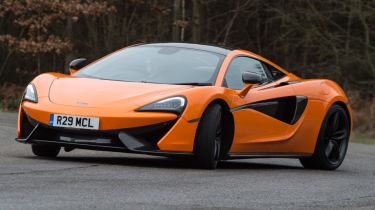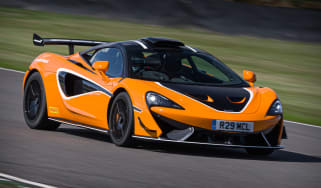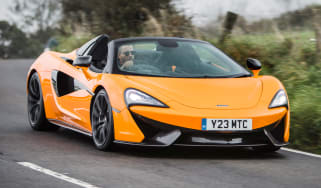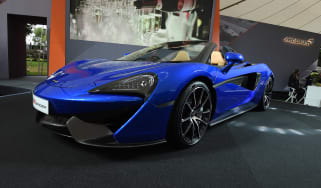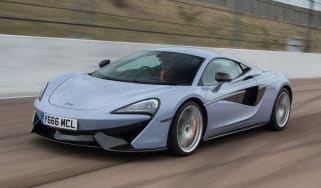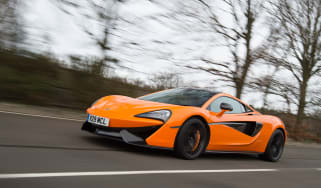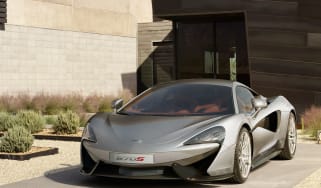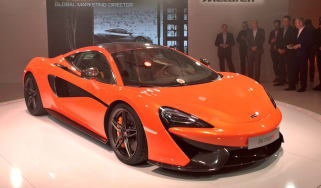McLaren 570S review
The McLaren 570S offers all the thrills you’d expect from the British maker’s Sport Series flagship

There was never any doubt about McLaren’s ability to build a stunning supercar, but when the 570S launched, it brought about a new level of flamboyance to the Woking manufacturer’s line-up – and all with a dash of added usability. Form still very much follows function, but there’s no doubt the model is a prettier car than its predecessors. It’s also easier to get in and out of, and there’s more space to put things in the cabin.
If you can get past the obvious issues of cost and practicality, this two-seater supercar is a very special way to enjoy motoring thrills. The McLaren’s handling and ride over British roads is almost peerless, and the performance from the muscular twin-turbo V8 is scintillating. The only real question marks are regarding reliability.
The McLaren 570S is the most popular model in the famous British car-maker’s line-up, with a 562bhp twin-turbo engine offering blistering performance – and with supercar looks to match. The McLaren 570S specs are designed to have the measure of two-seat mid or rear-engined sporting rivals such as the Audi R8, Ferrari 488 GTB and Porsche 911. It’s priced accordingly too, as the 570S price list kicks off at around £145,000.
Used - available now

2026 Audi
A1 Sportback
25,775 milesAutomaticPetrol1.5L
Cash £21,697
2023 Audi
A4
26,675 milesAutomaticPetrol2.0L
Cash £18,197
2026 Audi
A1 Sportback
21,082 milesManualPetrol1.0L
Cash £16,476
2023 Vauxhall
Combo Life Electric
19,305 milesAutomaticElectric
Cash £15,297The 570S is the hottest model in McLaren’s Sports Series, offering a slightly more dynamic driving experience than the (marginally) less powerful McLaren 540C and the more practical and ‘touring’ focused 570GT – although both those models share much of the 570S’s engineering and drivetrain.
You can opt for a 570S Coupe or the convertible 570S Spider, and there’s also a Track Pack for the Coupe version – with distinctive styling cues and a more focused drive. If you want to go faster and harder than the 570S allows, you need to move up a rung to the Woking manufacturer’s Super Series, which means the McLaren 720S.
As with all McLaren’s current line-up, the 570S is built around a carbon fibre central chassis tub – the latest variant, which underpins the 570S and its related models, is known as the MonoCell II. The firm’s 3.8-litre V8 engine also appears across the McLaren line-up in various states of tune.
There are no trim levels as such, but all models include a four-speaker stereo and McLaren’s IRIS infotainment system, as well as sat-nav, Bluetooth and leather upholstery. McLaren does provide a range of five Design Editions to help buyers choose from the array of ‘bespoke’ colour and finish options, or you can mix and match to your own taste through McLaren Special Operations.
The Track Pack is a popular option, featuring special lightweight alloy wheels, a contrasting roof colour and sports exhaust, while inside you get Alcantara trim and McLaren telemetry for track timing.
The Spider convertible has an electrically-operated lift off roof panel for truly exciting wind-in-the-hair motoring. It comes with a marginal 46kg weight penalty, but such is the stiffness of the MonoCell chassis it’s impossible to discern any meaningful difference in handling between the Spider and the Coupe.
Engines, performance and drive
There isn’t a McLaren on sale that’s not devastatingly quick and thrilling to drive, and it’s certainly true of the model at the top of the Sports Series. Slip behind the grippy wheel of the 570S and the excitement is palpable before you’ve even prodded the starter button.
Out on the road, the 570S delivers exactly the experience you’d expect from a car wearing McLaren badges. The suspension is less advanced than you’ll find on the Super Series models, utilising conventional roll bars, but while the ride is firm even in the adaptive dampers ‘Normal’ mode, the car moves fluidly over surface imperfections with barely any body roll. The ride is beautifully judged too, offering a level of comfort and compliance that’s remarkable given the awful state of British roads.
The steering is the icing on the 570S cake though, with perfect weighting, pin sharp responses and bucket-loads of feel through the wheel rim. It means you can place the nose of the 570S with precision – and at any half-sensible road speed, the car simply grips the tarmac and devours it. The ‘Sport’ and ‘Track’ drive mode settings add firmness by degrees and sharpen up throttle response and twin-clutch gearbox settings for lightning fast shifts.
The seven-speed gearbox is operated by big racing-car style paddles behind the steering wheel. Under full acceleration or during rapid downshifts, it flicks seamlessly between ratios as fast as you can think. Relax into a cruise, however, and the gearbox will slur its cogs happily and almost imperceptibly by itself.
The brakes on the 570S are pretty special too. They require a meaty push to haul the car down from speed, but there’s terrific feel through the pedal that allows you to modulate braking very precisely.
Track Pack equipped cars are 25kg lighter, while the bigger wing generates 29kg of downforce at 150mph. It’s otherwise very similar to drive, though, with little noticeable difference to road driving.
Engines
The 570S’s familiar 3.8-litre twin-turbo V8 may not have the spine-tingling yowl of an old-school, naturally aspirated V12 supercar, but it develops a fruity rasp at the top end and acceleration is accompanied by the whoosh of the turbos. It takes a split-second for the boost to build if you’re idling or coasting, but then the 570S takes off like a scalded cat.
The turbo effect means the acceleration seems to build exponentially, and with launch control engaged you can crack 0-60mph in 3.1 seconds. Top speed is 204mph for both Coupe and Spider, but the open-topped 570S takes one tenth of a second longer to reach 60mph.
MPG, CO2 and running costs
If you can afford a supercar, then worrying about the cost of running one might seem a bit churlish. Still, it’s worth knowing you can eke 26mpg out of a 570S if you want to extend your range between fuel stops. The fuel tank carries 72 litres of super unleaded, but it’s hard to imagine anyone driving a 570S to maximise economy. Owners may not be that interested in the 249g/km CO2 emissions, either.
Some will be interested in the company car tax cost of running a 570S, and with a 37 per cent Benefit-in-Kind rate you’ll be looking at annual tax bills of more than £20,000 before you’ve added any options to the basic £143k list price. Fuel benefit will add another £3,000 or so.
There’s a first year road tax/VED charge of £2,000, followed by a £450 annual charge that incorporates the ‘luxury’ car premium until the car’s sixth birthday, when VED reverts to £140.
Those running costs are par for the course at this exalted level of motoring, but the McLaren still looks better value than some rivals. But it’s easy to get carried away when it comes to adding options to your 570S – we recently tested one with added extras that included £3,500 worth of paint, a £3,000 sports exhaust and a £4,000 pack with reversing camera, parking sensors and nose-lift system. The latter item probably looks like good value when you consider the potential cost of repairs if you run into a sleeping policeman and need repairs, however.
Insurance groups
The 570S is a Group 50 car – the top banding for insurance. However, many owners will have a McLaren as one of a stable of cars, and will negotiate their own multi-car deal with their broker.
Depreciation
There’s no two ways about it… unless you’re buying a limited edition or particularly unique supercar, they’re all likely to cost you an arm and a leg in depreciation. McLaren reckons the 570S will stand up comparatively well, and that strong residual values mean dealers are able to offer a personal contract purchase scheme that can put you in the driving seat for just £995 per month over three years. Assuming you’ve got £35k for the deposit, of course.
To get an accurate valuation on a specific model check out our free car valuation tool...
Interior, design and technology
The 570S is undoubtedly a pretty car, and easily as eye-catching as any Porsche 911 or Audi R8. It is possibly a little less flamboyant than a Ferrari 488 GTB or Lamborghini Huracan, although with the 570S, McLaren clearly responded to criticism that its older models were a little too anodyne for some customers. The whole car is swoopier, and the back end especially has much more appeal from a design perspective.
Although from many angles it looks a lot like the 650S – which was the Super Series model that preceeded the current 720S – the 570S Sport Series was launched with a totally unique body made from aluminium. The metal panels are cheaper to produce and to repair than the composite items featured on the 650S. As you’d expect from McLaren, it’s not just any old aluminium, though. Many of the panels are shaped by a process called superforming, using heat and pressure to create complex curves that are no heavier than their composite equivalents.
The 570S also has a cabin that’s considerably upgraded over older models, with easier access over lower sills – although you still get the wacky dihedral doors that pivot upwards from the front – and various oddment storage areas including small door bins. Build quality is very good, and there’s a luxurious feel with high quality leather and Alcantara dominating.
Sat-nav, stereo and infotainment
McLaren has always made a big deal of its ‘driving first’ philosophy, and that purity of purpose is reflected in a steering wheel that’s refreshingly free of stereo controls, or drive mode selectors. There’s a binnacle ahead of the driver with a big central rev-counter dial and a digital speed readout, flanked by displays offering other essential driving info.
Sat-nav, smartphone connectivity, infotainment and climate control are taken care of by McLaren’s IRIS system, with its portrait-orientated touchscreen at the centre of the dash. It’s a bespoke system, and much easier to use than older versions thanks to more intuitive menus and shortcuts on the home screen. It’s still a little fiddly, however, and not as comprehensive as the setup in some rivals.
Standard sounds are provided by a four-speaker stereo, but there are a couple of upgrade options including a 1,280-watt system by Bowers and Wilkins.
Practicality, comfort and boot space
A two-seater supercar is hardly a practical choice, but there’s no doubt the McLaren 570S is better than some. Of course it’s not going to compete with the cabin space of a Porsche 911 with its 2+2 seating, but compared to an Audi R8 or Lamborghini Huracan the McLaren fares pretty well.
It’s not just the size of luggage space that makes the 570S a practical option, it’s also remarkably easy to drive, with a terrific view out over the low dashboard. The ride comfort is significantly better than the performance figures might suggest, too.
Dimensions and size
The McLaren 570S is 4,530mm long, 2,095mm wide and 1,202mm high. The Porsche 911 Turbo measures up at 4,507mm x 1,880mm x 1,297mm – in effect, fitting its four passengers onto a smaller patch of tarmac. The Audi R8 is a little more compact too, at 4,426mm x 1,940mm x 1,240mm.
Leg room, head room & passenger space
The 570S is pretty roomy for a two-seat supercar, and most drivers will find plenty of leg and headroom. There’s also plenty of adjustment for the driving seat and steering wheel, so you’ll easily find the right driving position. Just make sure you save your desired setup in the memory function – as it’ll default to an old setting if you’re not careful.
Boot space
The McLaren’s boot space is unsurprisingly a bit on the tight side, but look under the bonnet and you’ll find 144 litres of luggage space at the front of the car, which is roughly the same as a Lamborghini Huracan. There’s space for oddments inside the car, but no glovebox. A 570GT is more practical, with a small, side-hinged boot behind the front seats.
Reliability and safety
Despite the fact it hasn’t been (and won’t be) tested by Euro NCAP, the advanced technology present in McLaren’s MonoCell carbon tub, plus years of racing experience, go together to make the 570S a reassuring bet on the safety front. Which is just as well, because the chances are that if you lose control of a car such as this you’ll be travelling at silly speeds.
As a pure driving machine, you’ll not be surprised to learn McLaren doesn’t load the 570S up with advanced driving aids such as autonomous braking, lane-keeping or cross traffic sensors. Aside from the chassis stability package with its various driving modes, the ‘active safety’ is limited to a reversing camera and parking sensors. Traction and stability control is included, of course.
Engine reliability should be pretty good, as McLaren’s 3.8-litre V8 has been around for a few years now. But despite the company having had had plenty time to develop and validate its electronics and infotainment system – which was frankly pretty dodgy on early versions of the 12C – there have been a few notable electrical gremlins that may worry potential buyers.
You’re unlikely to find fault with the build quality of standard of materials, however.
Warranty
All McLarens come with a three-year, unlimited mileage warranty, with the option to extend cover for up to 12 years.
Servicing
Scare stories about the cost of supercar maintenance are one of the reasons Ferrari offers ‘free’ servicing for seven years. McLaren charges less upfront to buy the 570S than you need to purchase a 488 GTB, but you will have to pick up your own servicing tab. With expensive consumables (and stiff labour rates) you definitely need to know what you’re letting yourself in for.

